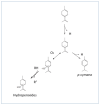Essential Oils in Livestock: From Health to Food Quality
- PMID: 33672283
- PMCID: PMC7926721
- DOI: 10.3390/antiox10020330
Essential Oils in Livestock: From Health to Food Quality
Abstract
Using plant essential oils (EOs) contributes to the growing number of natural plants' applications in livestock. Scientific data supporting the efficacy of EOs as anti-inflammatory, antibacterial and antioxidant molecules accumulates over time; however, the cumulative evidence is not always sufficient. EOs antioxidant properties have been investigated mainly from human perspectives. Still, so far, our review is the first to combine the beneficial supporting properties of EOs in a One Health approach and as an animal product quality enhancer, opening new possibilities for their utilization in the livestock and nutrition sectors. We aim to compile the currently available data on the main anti-inflammatory effects of EOs, whether encapsulated or not, with a focus on mammary gland inflammation. We will also review the EOs' antioxidant activities when given in the diet or as a food preservative to counteract oxidative stress. We emphasize EOs' in vitro and in vivo ruminal microbiota and mechanisms of action to promote animal health and performance. Given the concept of DOHaD (Developmental Origin of Health and Diseases), supplementing animals with EOs in early life opens new perspectives in the nutrition sector. However, effective evaluation of the significant safety components is required before extending their use to livestock and veterinary medicine.
Keywords: antimicrobial; antioxidant; encapsulation; essential oils; fermentation; immunity; inflammation; livestock; mastitis; nutrition.
Conflict of interest statement
The authors declare no conflict of interest.
Figures






Similar articles
-
Much More Than a Pleasant Scent: A Review on Essential Oils Supporting the Immune System.Molecules. 2019 Dec 11;24(24):4530. doi: 10.3390/molecules24244530. Molecules. 2019. PMID: 31835699 Free PMC article. Review.
-
Use of Essential Oils in Veterinary Medicine to Combat Bacterial and Fungal Infections.Vet Sci. 2020 Nov 30;7(4):193. doi: 10.3390/vetsci7040193. Vet Sci. 2020. PMID: 33266079 Free PMC article. Review.
-
Current Trends in the Utilization of Essential Oils for Polysaccharide- and Protein-Derived Food Packaging Materials.Polymers (Basel). 2022 Mar 13;14(6):1146. doi: 10.3390/polym14061146. Polymers (Basel). 2022. PMID: 35335477 Free PMC article. Review.
-
In Vitro Antioxidant, Antimicrobial, Anticoccidial, and Anti-Inflammatory Study of Essential Oils of Oregano, Thyme, and Sage from Epirus, Greece.Life (Basel). 2022 Nov 4;12(11):1783. doi: 10.3390/life12111783. Life (Basel). 2022. PMID: 36362938 Free PMC article.
-
Essential oils: A promising eco-friendly food preservative.Food Chem. 2020 Nov 15;330:127268. doi: 10.1016/j.foodchem.2020.127268. Epub 2020 Jun 8. Food Chem. 2020. PMID: 32540519 Review.
Cited by
-
Effects of essential oils on economically important characteristics of ruminant species: A comprehensive review.Anim Nutr. 2023 Oct 20;16:1-10. doi: 10.1016/j.aninu.2023.05.017. eCollection 2024 Mar. Anim Nutr. 2023. PMID: 38131027 Free PMC article. Review.
-
Animal Food Products to Support Human Nutrition and to Boost Human Health: The Potential of Feedstuffs Resources and Their Metabolites as Health-Promoters.Metabolites. 2024 Sep 13;14(9):496. doi: 10.3390/metabo14090496. Metabolites. 2024. PMID: 39330503 Free PMC article. Review.
-
Effects of essential oils on calf growth, ruminal fermentation, and antioxidative status: a meta-analysis.Front Vet Sci. 2025 Jun 2;12:1573846. doi: 10.3389/fvets.2025.1573846. eCollection 2025. Front Vet Sci. 2025. PMID: 40530026 Free PMC article.
-
Rumen microbiota succession throughout the perinatal period and its association with postpartum production traits in dairy cows: A review.Anim Nutr. 2024 May 6;18:17-26. doi: 10.1016/j.aninu.2024.04.013. eCollection 2024 Sep. Anim Nutr. 2024. PMID: 39022774 Free PMC article. Review.
-
Recent development in the preservation effect of lactic acid bacteria and essential oils on chicken and seafood products.Front Microbiol. 2022 Dec 23;13:1092248. doi: 10.3389/fmicb.2022.1092248. eCollection 2022. Front Microbiol. 2022. PMID: 36620022 Free PMC article. Review.
References
-
- Lesage M. Les Antibiorésistances en Élevage: Vers des Solutions Intégrées. MONTREUIL SOUS BOIS. [(accessed on 13 January 2021)]; Available online: https://agriculture.gouv.fr/sites/minagri/files/cep_analyse82_antibiores....
-
- Wall B.A., Mateus A.L.P., Marshall L., Pfeiffer D.U., Lubroth J., Ormel H.J., Otto P., Patriarchi A. Drivers, Dynamics and Epidemiology of Antimicrobial Resistance in Animal Production. Food and Agriculture Organization of the United Nations; Rome, Italy: 2016. [(accessed on 14 February 2021)]. Available online: http://www.fao.org/publications/card/fr/c/d5f6d40d-ef08-4fcc-866b-5e5a92...
Publication types
Grants and funding
LinkOut - more resources
Full Text Sources
Other Literature Sources

